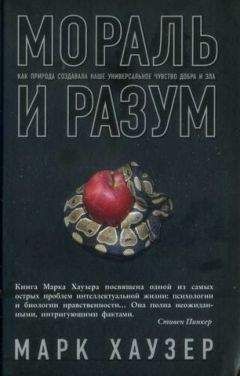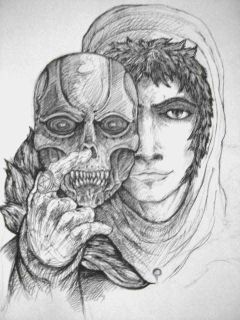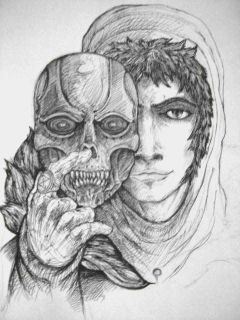Saffran J. R.,Aslin R. N. & Newport E. L. (1996). Statistical learning by 8-month-old infants // Science, 274, 1926—1928.
Sanfey A. G., Rilling J. K., Aronson J. A., Nystrom L. E. & Cohen J. D. (2003). The neural basis of economic decision making in the ultimatum game // Science, 300, 1755—1758.
Santos I., Flombaum J. & Hauser M. D. (in prep). Rhesus monkey expectations about object motion. Unpublished manuscript, Cambridge, MA.
Santos L. R. & Hauser M. D. (1999). How monkeys see the eyes: cotton-top tamarins’ reaction to changes in visual attention and action // Animal Cognition, 2, 131—139.
Sapolsky R. (1994). Individual differences and the stress response // Seminars in Neurosciences, 6, 261—269.
Sapolsky R. (1998). The Trouble with Testosterone. New York: Scribner.
Sapolsky R. (2001). A Primate’s Memoir. New York: Scribner.
Sapolsky R. & Share L. (2004). A pacific culture among mid baboons: Its emergence and transmission. Public Library of Science Biology, 2: el06. doi: 10.1371/journal.pbio.0020106 [2.
Saporta S. (1978). An interview with Noam Chomsky // Linguistic Analysis, 4 [4], 301—319.
Scheel D. & Packer C. (1991). Group hunting behaviour of lions: a search for cooperation // Animal Behaviour, 41, 697—709.
Sckelling T (1960). The Strategy of Conflict. Cambridge, MA: Harvard University Press.
Schlottmann A., Alien D., Linderoth C. & Hesketh S. (2002). Perceptual causality in children // Child Development, 73, 1656—1677.
Schlottmann A. & Surian L. (1999). Do 9-month-olds perceive causation-at-a-distance? // Perception, 28, 1105—1113.
Scholl B. J. & Nakayama K. (2002). Causal capture: contextual effects on the perception of collision events // Psychological Science, 13, 493—498.
Scholl B. J. & Tremoulet P. (2000). Perceptual causality and animacy // Trends in Cognitive Science, 4, 299—309.
Schultz W., Dayan P & Montague P R. (1997). A neural substrate of prediction and reward // Science, 275, 1593—1599.
Schultz W. & Dickinson A. (2000). Neuronal coding of prediction errors // Annual Review of Neuroscience, 23, 473—500.
Sethi A. у Mischel W.y Aher J. L., Shoda Y & Rodriguez M. L. (2000). The role of strategic attention deployment in development of self-regulation: predicting preschoolers’ delay of gratification from mother-toddler interactions // Developmental Psychology, 36, 767—777.
Seyfarth R. M. & Cheney D. (2003). Hierarchical social knowledge of monkeys // F. В. M. d. Waal & P L. Tyack (Eds.), Animal Social Complexity: Intelligence, Culture, and Individualized Societies (p. 207—229). Cambridge, MA: Harvard University Press.
Seyfarth R. M. & Cheney, D. L. (1984). Grooming alliances and reciprocal altruism in vervet monkeys // Nature, 308, 541—543.
Shakespeare W. (1914). Macbeth. London: Oxford University Press.
Shallice T (1988). From Neuropsychology to Mental Structure. Cambridge: Cambridge University Press.
Shaw G. B. (1916). Pygmalion. Bartleby. Available: http://www.bartleby.com/138/.
Shepher J. (1971). Mate selection among second generation kibbutz adolescents and adults: incest avoidance and negative imprinting // Archives of Sexual Behaviour, 1, 293—307.
Sherman N. (1989). The Fabric of Character: Aristotle’s Theory of Virtue. New York: Oxford University Press.
Shimizu Y. A. dc Johnson S. C. (2004). Infants’ attribution of a goal to a morphologically unfamiliar agent // Developmental Science, 7, 425—430.
Siegal M. & Peterson С. C. (1998). Preschoolers’ understanding of lies and innocent and negligent mistakes // Developmental Psychology, 34, 332—341.
Sih A. & Mateo J. (2001). Punishment and persistence pay: a new model of territory establishment and space use // Trends in Ecology and Evolution, 16, 477—479.
Silk J. (2002a). The form and function of reconciliation in primates // Annual Review of Anthropology, 31, 21—44.
Silk J. (2002b). Practice random acts of aggression and senseless acts of intimidation: the logic of status contests in social groups // Evolutionary Anthropology, 11, 221—225.
Silk J. B. (2003). Cooperation without counting: the puzzle of friendship // P Hammerstein (Ed.), Genetic and Cultural Evolution of Cooperation (p. 37—54). Cambridge, MA: MIT Press.
Simon H. A. (1990). Invariants of human behavior // Annual Review of Psychology, 41, 1—19.
Singer P (1972). Famine, affluence, and morality // Philosophy and Public Affairs, 1/3, 229—243.
Singer P (1993). Practical Ethics. Cambridge: Cambridge University Press.
Singer P (2000). A Darwinian Left. New Haven, CT: Yale University Press.
Smetana J. (1995). Morality in context: abstractions, ambiguities and applications // Annals of Child Development, 10, 83—130.
Smetana J. (2005). Social-cognitive domain theory: consistencies and variations in children’s moral and social judgments // M. Killen & J. G. Smetana (Eds.), Handbook of Moral Development. Mahwah, NJ: Lawrence Erlbaum Publishers.
Smuts В. B. (1987). Gender, aggession, and influence // В. B. Smuts & T. S. Struhsaker & R. Seyfarth & D. Cheney & R. W Wrangham (Eds.), Primate Societies (p. 400—412). Chicago: University of Chicago Press.
Sober E. (1994). From a Biological Point of View. Cambridge: Cambridge University Press.
Sober E. & Wilson D. S. (1998). Unto Others. Cambridge, MA: Harvard University Press.
Sodian B., Taylor C, Harris P L. & Pemer J. (1991). Early deception and the child’s theory of mind: false trains and genuine markers // Child Development, 62, 468—483.
Solomon R. C. (2002). Back to basics: on the very idea of “basic emotions” // Journal for the Theory of Social Behavior, 32, 115—144.
Sorensen R. (1991). Thought experiments // American Scientist, May—June, 250— 263.
Spelke E. (2000). Core knowledge // American Psychologist, 55, 1233—1243.
Spelke E. S. (1994). Initial knowledge: six suggestions // Cognition, 50, 431—445.
Sperber D. & Girotto V. (in press). Does the selection task detect cheater-detection? //J. Fitness & K. Sterelny (Eds.), New Directions in Evolutionary Psychology. Abingdon, UK: Taylor & Francis.
Spikka M., Newberry R. C. & BekoffM. (2001). Mammalian pay: training for the unexpected // Quarterly Review of Biology, 76, 141—168.
Sprengelmeyer R., Young A. W., Calder A. J., Kamat A., Lange H., Homberg V, Perrett D. I. & Rowland D. (1996). Loss of disgust: perception of faces and emotions in Huntington’s disease // Brain, 119, 1647—1665.
Sprengelmeyer R., Young A. W., Pundt /., Sprengelmeyer A., Calder A. J., Berrios G., Wingkel R., Vollmoeller W., Kuhn W., Sartory G. & Przuntek H. (1997). Disgust implicated in obsessive-compulsive disorder // Proceedings of the Royal Society of London, В, B264, 1767—1773.
Stammbach E. (1988). Group responses to specially skilled individuals in a Macaca fascicularis // Behaviour, 107, 241—266.
Stamps J. A. & Krishnan V. V. (1999). A learning-based model of territory establishment // Quarterly Review of Biology, 74, 291—318.
Stephens D. W., McLinn С. M. & Stevens J. R. (2002). Discounting and reciprocity in an iterated prisoner’s dilemma // Science, 298, 2216—2218.
Stevens D., Chairman T & Blair R. J. R. (2001). Recognition of emotion in facial expressions and vocal tones in children with psychopathic tendencies // Journal of Genetic Psychology, 162, 201—211.
Stevens J. R. (2004). The selfish nature of generosity: harassment and food sharing in primates // Proceedings of the Royal Society, London, B, 271, 451—456.
Stevens J. R., Cushman F A. & Hauser M. D. (2005). Evolving the psychological mechanisms for cooperation // Annual Review of Ecology and Systematics, 36, 499—518.
Stevens J. R., Hallinan E. V. & Hauser M. D. (2005). The ecology and evolution of patience in two New World primates // Biology Letters, 1, 223—226.
Stevenson-Hinde J., Stillwel-Barnes R. & Zunz M. (1980). Subjective assessment of rhesus monkeys over four sucessive years // Primates, 21, 223—233.
Stingl M. & Colier J. (2005). Reasonable partiality from a biological point of view // Ethical Theory and Moral Practice, 8, 11—24.
Stone V. E., Cosmides L., Toohy J., Kroll N. & Knight R. T. (2002). Selective impairment of reasoning about social exchange in a patient with bilateral limbic system damage // Proceedings of the National Academy of Sciences, USA, 99, 11531— 11536.
Sunstein C. R., Hastie R., Payne J. W., Schkade D. A. & Viscusi W. К (2002). Punitive Damages. How Juries Decide. Chicago: University of Chicago Press.
Sweetser E. (1987). The definition of “lie”: an examination of the folk models underlying a semantic prototype // D. Hollard & N. Quinn (Eds.), Cultural Models in Language and Thought. New York: Cambridge University Press.
Talwar V & Lee K. (2002). Development of lying to conceal a transgression: children’s control of expressive behaviour during verbal deception // International Journal of Behavioral Development, 26, 436—444.
Talwar V, Lee K, Bala N. & Lindsay R. C. L. (2002). Children’s conceptual knowledge of lying and its relation to their actual behaviors: implications for court competence examinations // Law and Human Behavior, 26, 395—415.
Tarr M. J. & Gauthier I. (2000). FFA: A flexible fusiform area for subordinate-level visual processing automatized by expertise 11 Nature Neuroscience, 3, 764—769.
Tetlock P. E. (2003). Thinking the unthinkable: sacred values and taboo cognitions // Trends in Cognitive Science, 7, 320—324.
Tetlock P. E., Kristel О. V, Elson S. B. & Lemer J. S. (2000). The psychology of the unthinkable: taboo trade-offs, forbidden base rates, and heretical counterfactuals // Journal of Personality and Social Psychology, 78, 853—870.
Thompson С, Barresi J. & Moore С. (1997). The development of future-oriented prudence and altruism in preschoolers // Cognitive Development, /2, 199—212.
Thomson J.J. (1970). Individuating actions //Journal of Philosophy, 68, 774—781.
Thomson J. J. (1971). A defense of abortion // Philosophy and Public Affairs, /, 47—66.
Tinkelpaugh O. L. (1928). An experimental study of representative factors in monkeys //Journal of Comparative Psychology, 8> 197—236.
Tinkelpaugh O. L. (1932). Multiple delayed reaction with chimpanzees and monkeys // Journal of Comparative Physiological Psychology, 13, 207—224.
Tobin //., Longue A. W., Chelonis J. J. & Ackerman К. T (1996). Self-control in the monkey Macaca fascicularis // Animal Learning and Behavior, 24, 168—174.
Todd P. M. & Gigerenzer G. (2003). Bounding rationality to the world // Journal of Economic Psychology, 24, 143—165.
Tomasello M. & G*// /. (1997). Primate Cognition. Oxford: Oxford University Press.
Tomasello M.y Call J. & Hare B. (2003). Chimpanzees understand psychological states — the question is which ones and to what extent // Trends in Cognitive Science, 7, 153—156.
Tomasello M.y Carpenter M.y Call/., Behne T & Moll H. (2005). Understanding and sharing intentions: the origins of cultural cognition // Behavioral and Brain Research, 28, 795—855.
Tooby J. & Cosimdes L. (1998). Friendship and the Banker’s Paradox: Other pathways to the evolution of adapations for altruism // W G. Runciman & J. M. Smith & R. I. M. Dunbar (Eds.), Evolution of Social Behaviour Patterns in Primates and Man (p. 299—323). Oxford: Oxford University Press.
Tranel Z)., BecharaA. & Damasio A. (2000). Decision making and the somatic marker hypothesis // M. Gazzaniga (Ed.), The New Cognitive Neurosciences (p. 1047—1061). Cambridge, MA: MIT Press.




